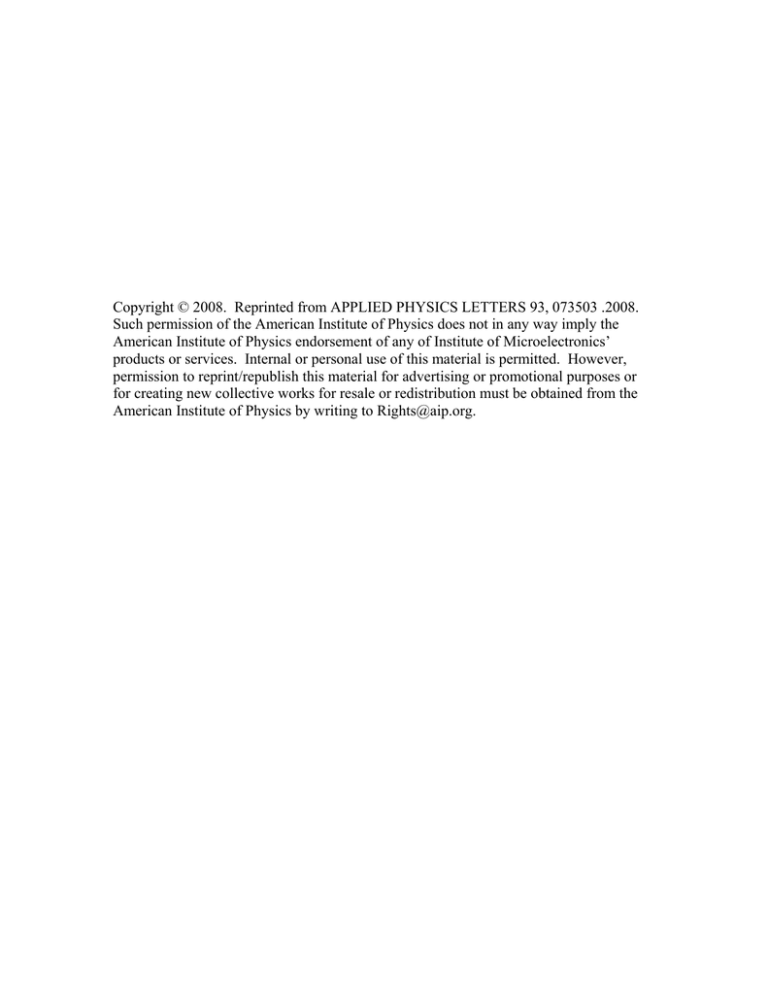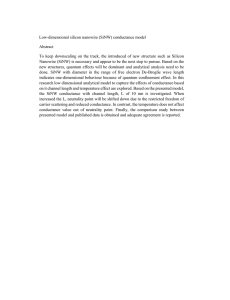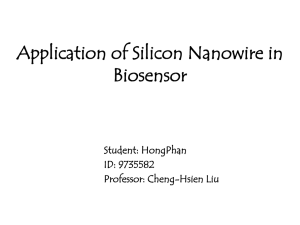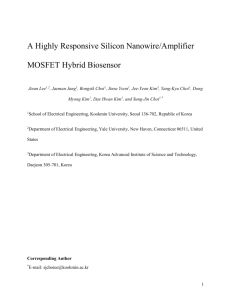Copyright © 2008. Reprinted from APPLIED PHYSICS LETTERS 93
advertisement

Copyright © 2008. Reprinted from APPLIED PHYSICS LETTERS 93, 073503 .2008. Such permission of the American Institute of Physics does not in any way imply the American Institute of Physics endorsement of any of Institute of Microelectronics’ products or services. Internal or personal use of this material is permitted. However, permission to reprint/republish this material for advertising or promotional purposes or for creating new collective works for resale or redistribution must be obtained from the American Institute of Physics by writing to Rights@aip.org. APPLIED PHYSICS LETTERS 93, 073503 共2008兲 Improved carrier injection in gate-all-around Schottky barrier silicon nanowire field-effect transistors J. W. Peng,1,2 S. J. Lee,1,a兲 G. C. Albert Liang,1 N. Singh,2 S. Y. Zhu,2 G. Q. Lo,2 and D. L. Kwong2 1 Silicon Nano Device Lab, Department of Electrical and Computer Engineering, National University of Singapore, Singapore 117576, Singapore 2 Institute of Microelectronics, 11 Science Park Road, Science Park II, Singapore 117685, Singapore 共Received 20 May 2008; accepted 30 July 2008; published online 22 August 2008兲 This letter presents the performance improvement of Schottky barrier metal-oxide-semiconductor field-effect transistor by employing gate-all-around 共GAA兲 Si-nanowire 共SiNW兲 structure. Without employing any barrier lowering technique, the mid-band-gap Ni-silicide Schottky barrier transistors demonstrated excellent performance and achieved subthreshold slope of ⬃86 mV/ decade and on-current of 19 A / m on a 12.5 nm SiNW, and subthreshold slope of ⬃79 mV/ decade and on-current of 207 A / m on a 4 nm diameter SiNW. Assisted with simulation, we show that this improvement can be attributed to the strong reduction in the Schottky barrier thickness as a result of the better gate control of GAA SiNW structure. © 2008 American Institute of Physics. 关DOI: 10.1063/1.2973211兴 Silicide based Schottky-barrier 共SB兲 source/drain 共S/D兲 metal-oxide-semiconductor field-effect transistor 共MOSFET兲 has attracted renewed attention due to its inherent advantage in device scalability, especially applicable for the sub-10-nm gate-length devices due to its highly conductive metal S/D, atomically abrupt junctions as defined by the silicide-silicon interface achieved by a low-temperature process.1 However, it is suggested that the S/D SB height 共SBH兲 should be less than 0.1 eV in order to obtain comparable current drivability as the conventional p / n-doped S/D MOSFET.2 Moreover, the reported SBH of the p-channel MOSFETcandidate PtSi3 is ⬃0.2 eV and that of n-channel MOSFETcandidate, such as ErSi4 or YbSi,5 is ⬃0.27– 0.36 eV. In view of lack of silicide with sufficiently low SBH at present, it is important to turn the effort to minimize the SB width to maximize the tunneling current. Meanwhile, for the channel/gate structure, the gate-all-around 共GAA兲 Si-nanowire 共SiNW兲 MOSFET structure is considered as a potential candidate for the endof-the-roadmap devices for its better electrostatic control.6 Therefore, there is great interest to assess the GAA SiNW channel device integrated with SB S/D contact. In this letter, we demonstrate enhanced tunneling current for a GAA SiNW structure with NiSi intentionally encroached through the spacer in a SB MOSFET. For a gate length of 150–850 nm, the mid-band-gap NiSi SB MOSFETs with GAA SiNW structure demonstrate excellent device characteristics in terms of small subthreshold slope 共SS兲 and large Ion / Ioff ratio. Top-gated 共TG兲 planar silicon-oninsulator 共SOI兲 and GAA SiNW structures are compared, and the GAA SiNW structure is identified as the dominant factor for the carrier injection enhancement. SiNWs were formed by the self-limited oxidation of the Si-Fin—details can be found elsewhere.7 Then the ⬃5 nm gate oxide was thermally grown, followed by 100 nm low pressure chemical vapor deposition ␣-Si deposition, implantation with P / 4 ⫻ 1015 cm2 / 25 keV, and activation a兲 Author to whom correspondence should be addressed. Electronic mail: elelsj@nus.edu.sg. 0003-6951/2008/93共7兲/073503/3/$23.00 共1050 ° C for 10 s兲. The polycrystalline silicon gate was patterned to have the edges of SiNW exposed for silicidation. Subsequently, 100 Å SiO2 / 150 Å SiN stack was deposited and etched to form a thin spacer. Then 1 nm Ti / 9 nm nickel was sputtered after cleaning of the remaining oxide. Silicide was formed at both of the exposed SiNW and S/D pads by rapid thermal annealed 共RTA兲 at 500 ° C for 30 s. In previous studies, Lu et al.8 reported that NiSi encroaches into a 37.5 nm SiNW after annealing with diffusion speed of 1.1 Å / s; Appenzeller et al.9 reported that NiSi has a faster diffusion speed along SiNW with smaller diameter. Based on these works, we estimate that the NiSi in our SiNW devices have encroached through the thin spacer 共⬃15 nm兲 after 500 ° C for 30 s RTA process and the final device structure is shown in Fig. 1共a兲. The SiNW cross section transmission electron microscope 共TEM兲 images of a 4 nm diameter and a 12.5 nm width SiNWs, which are investigated in this work, are shown in Figs. 1共b兲 and 1共c兲. Figure 2 shows the transfer characteristics of a 4 nm diameter SiNW, a 12.5 m width SiNW, and a 1 m width FIG. 1. 共Color online兲 共a兲 The device schematic of the GAA SiNW SB MOSFET. 共b兲 TEM image of the 4 nm diameter SiNW cross section. 共c兲 TEM image of the 12.5 nm diameter SiNW cross section. 93, 073503-1 © 2008 American Institute of Physics Downloaded 20 Apr 2009 to 202.6.242.69. Redistribution subject to AIP license or copyright; see http://apl.aip.org/apl/copyright.jsp 073503-2 Peng et al. FIG. 2. 共Color online兲 The Id-Vg characteristics of the 4 nm and 12.5 nm diameter GAA SiNW and the 100 nm Si thickness TG SOI NiSi S/D SB MOSFETs. The inset is the energy band diagram of the NiSi SB MOSFET at on-state with −1.2 V drain bias. planar SOI SB MOSFETs on a single wafer without normalization. The gate length of the 4 nm diameter SiNW is 150 nm, and the gate lengths of the 12.5 nm width SiNW and 1 m width planar SOI device are 850 nm. To assist the discussion, the inset in Fig. 2 describes the energy band diagram of the device at on-state. Due to the large SB of NiSi for hole, the carrier transport is dominated by the tunneling current through the source barrier. Results show that the use of GAA SiNW structure improves the SS, the on-current, as well as the off-current of SB MOSFETs. The SS of the 4 nm diameter and 12.5 nm width SiNW is 79 and 86 mV/decade, respectively, which is much smaller than the 442 mV/decade of the 1 m width 100 nm body thickness TG planar SOI device. Since the SB of NiSi for holes is ⬃0.47 eV,10 which is much larger than kT, carrier transport related to thermionic emission can be neglected and SS is dominated by the change in the tunneling probability through the SB with changing gate bias. Even though SS is influenced by changes in the depletion charge as well as by trapped charges at the Si/ SiO2 interface with changing Vg, these factors have been estimated to have a minor effect on SS in undoped SB MOSFETs.11 Therefore, SS represents a robust measurement of the carrier injection in SB MOSFETs, and the carrier injection has been improved in SB MOSFETs based on GAA SiNW architecture. This improvement is significant in that the SS of a 12.5 nm SiNW is 86 mV/decade while the theoretical SS of a 12.5 nm Si body TG planar SOI SB MOSFET is ⬃254 mV/ decade with the same gate oxide thickness.11 The GAA SiNW SB MOSFETs achieved the on-current of 19 A / m from the 12.5 nm width SiNW with 850 nm gate length, which is much larger than the on-current of 0.33 A / m for the 100 nm body thickness TG planar SOI device with same gate length. Under the biases of Vg = −2.3 V and Vds = −1.2 V, the 4 nm diameter, 150 nm gatelength SiNW SB MOSFET with 5 nm gate oxide achieved smaller SS of 79 mV/decade and large on-current of 207 A / m, which is comparable to those of conventional p / n-doped S/D MOSFETs.7 This on-current improvement can also be understood by the carrier injection improvement in GAA SiNW architecture. The subthreshold current of SB MOSFET can be modeled using the thermionic emission equation Appl. Phys. Lett. 93, 073503 共2008兲 FIG. 3. 共Color online兲 The effective SBH of the 4 nm and 12.5 nm diameter GAA SiNW SB MOSFETs, and TG 100 nm Si body SOI SB MOSFET as the function of gate bias. I = wAⴱⴱT2 exp共− qeff/KT兲关exp共qV/KT兲 − 1兴, 共1兲 where w is the physical geometry factor, Aⴱⴱ is the effective Richardson constant, k is the Boltzmann constant, T is temperature, and V is the drain source bias. As the gate bias increases in subthreshold regime, i.e., Vg ⬍ Vt, the SB becomes thinner due to the gate bias and the contribution of the tunneling current will become larger while the contribution from the thermionic current will not change. Hence, the overall current will become less sensitive to the temperature change and the effective SBH becomes smaller. Therefore, effective SBH can be a measure to investigate the tunneling current in SB MOSFET. A series of subthreshold characteristics at large drain bias 共−1.2 V兲 was measured at 260– 360 K, and the experimental effective SBH as a function of gate voltage was obtained and shown in Fig. 3. All three devices 共4 nm and 12.5 nm GAA SiNW SB MOSFETs and TG SOI SB MOSFET兲 show ⬃0.45 eV effective SBH at −1 V gate bias, close to its real SBH. As the gate bias becomes larger 共negatively兲, the effective SBH of the 4 nm SiNW decreases faster than that of the 12.5 nm GAA SiNW SB MOSFET and the TG SOI SB MOSFET. This faster decrease in the effective SBH suggests that the carrier injection increases much faster in 4 nm GAA SiNW SB MOSFET than in 12.5 nm GAA SiNW SB MOSFET and faster in GAA SiNW than in TG SOI devices due to better gate coupling. The observed negative barrier height indicates that NiSi/SiNW contact shows Ohmic-contact-like behavior under high gate bias due to the dominance of tunneling effects. Comparable barrier heights between 4 nm and 12.5 nm GAA SiNW SB MOSFETs are observed in this tunneling-dominant high gate bias condition. For a quantitative analysis on the impact of gate structure over the tunneling current at the on-state gate bias, the barrier shape of TG planar SOI and GAA SiNW devices was numerically solved by MEDICI in cylindrical coordinates with the parameters set to be the same as the experimental devices described above. The potential profile along the 2 nm below the gate oxide surface of TG planar SOI device and GAA SiNW is plotted at the inset of Fig. 4. It was reported that for TG planar SOI SB MOSFETs, thinner body thickness could result in smaller SS;11 therefore, the potential profile of a 4 nm and 12.5 nm TG planar SOI SB MOSFETs was solved and plotted in the same graph for fair comparison. Results show that at the on-state gate bias, SiNW with 12.5 nm di- Downloaded 20 Apr 2009 to 202.6.242.69. Redistribution subject to AIP license or copyright; see http://apl.aip.org/apl/copyright.jsp 073503-3 Appl. Phys. Lett. 93, 073503 共2008兲 Peng et al. GAA SiNW structure is a means to improve the electrical characteristics of SB MOSFETs. In conclusion, we have demonstrated that carrier injection is greatly enhanced in GAA SiNW SB MOSFET due to the better gate modulation of the SB shape. With the advantage of GAA SiNW structure, the mid-band-gap NiSi SB MOSFETs achieved a SS of 79 mV/decade from a 4 nm SiNW device and a SS of 86 mV/decade from a 12.5 nm device at room temperature. J.W.P. acknowledges financial support from the Chartered Semiconductor Manufacturing Singapore for his Ph.D. work at the National University of Singapore. 1 FIG. 4. 共Color online兲 The simulated barrier FWHM 共X1/2兲 as the function of the Si body thickness of the TG planar SOI device and the GAA SiNW diameter in NiSi SB MOSFET at on-state. The inset is the potential profile at 2 nm below the gate oxide surface of the GAA SiNW and TG SOI device at on-state, where the x axis D represents the distance from the silicide/ channel junction. ameter has a thinner SB than a 4 nm SOI device. This agrees with the experimental data, where the 12.5 nm SiNW device has a SS ⬃86 mV/ decade while the theoretical SS for a 4 nm SOI is larger than 150 mV/decade.11 The barrier full width at half maximum 共FWHM兲 x1/2 as a function of the SOI body thickness or SiNW diameter is shown in Fig. 4. It clearly demonstrates the advantage of GAA SiNW SB MOSFETs in terms of obtaining a thinner SB at a given gate bias. Given the exponential dependence of tunneling current on the SB width and the enhanced barrier thinning effect of GAA SiNW structure, we have demonstrated that the use of J. M. Larson and J. P. Snyder, IEEE Trans. Electron Devices 53, 1048 共2006兲. 2 D. Connelly, C. Faulkner, and D. E. Grupp, IEEE Electron Device Lett. 24, 411 共2003兲. 3 J. P. Snyder, C. R. Helms, and Y. Nishi, Appl. Phys. Lett. 67, 1420 共1995兲. 4 M. Jang, Y. Kim, J. Shin, and S. Lee, IEEE Electron Device Lett. 26, 354 共2005兲. 5 S. Zhu, J. Chen, M.-F. Li, S. J. Lee, J. Singh, C. X. Zhu, A. Du, C. H. Tung, A. Chin, and D. L. Kwong, IEEE Electron Device Lett. 25, 565 共2004兲. 6 C. P. Auth and J. D. Plummer, IEEE Electron Device Lett. 18, 74 共1997兲. 7 N. Singh, A. Agarwal, L. K. Bera, T. Y. Liow, R. Yang, S. C. Rustagi, C. H. Tung, R. Kumar, G. Q. Lo, and N. Balasubramanian, IEEE Electron Device Lett. 27, 383 共2006兲. 8 K.-C. Lu, K. N. Tu, W. W. Wu, L. J. Chen, B.-Y. Yoo, and N. V. Myung, Appl. Phys. Lett. 90, 253111 共2007兲. 9 J. Appenzeller, J. Knoch, E. Tutuc, M. Reuter, and S. Guha, Tech. Dig. Int. Electron Devices Meet. 2006, 555. 10 H. Iwai, T. Ohguro, and S. Ohmi, Microelectron. Eng. 60, 157 共2002兲. 11 M. Zhang, J. Knoch, J. Appenzeller, and S. Mantl, IEEE Electron Device Lett. 28, 223 共2007兲. Downloaded 20 Apr 2009 to 202.6.242.69. Redistribution subject to AIP license or copyright; see http://apl.aip.org/apl/copyright.jsp





